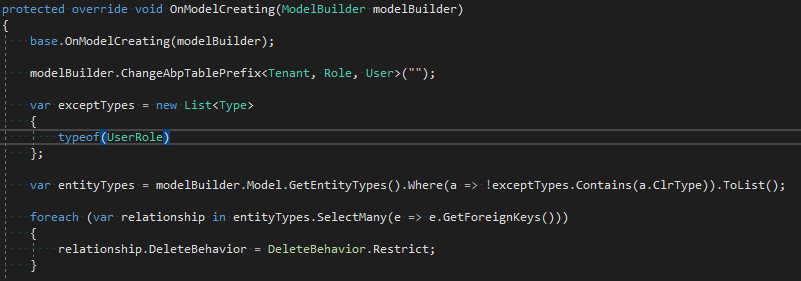Hello, I changed all my foreign keys to delete restrict instead of delete cascade because delete cascade was giving issues during migrations of my new entities. (I have some parent child recursive referencing and they wont allow me to delete cascade)
However, now running the tests failed for Update_User_Basic_Tests and Should_Remove_From_Role.
Message: System.InvalidOperationException : The association between entity types 'User' and 'UserRole' has been severed but the foreign key for this relationship cannot be set to null. If the dependent entity should be deleted, then setup the relationship to use cascade deletes.
I was thinking of changing the table to fully audited so it doesn't actually delete the record and prevent throwing this error? Or have any other way to solve this issue? Thanks
11 Answer(s)
-
0
Hi,
I couldn't think of a better solution at the moment. I suggest you to test your application when you did this change carefully.
Thanks for the suggestion, I think it will help others.
-
0
Hello ismcagdas, I'm getting this error. I get the same error when I want to remove the role in the user update. Do you have any suggestions Solution? The system is currently running live, i can not perform table changes.
Regards.
-
0
Might have forgotten to attach the error screenshot ?
-
0
The error message is as follows. I understand that the UserRole table should be FullAudited.
INFO 2018-04-16 21:45:44,053 [3 ] uthentication.JwtBearer.JwtBearerHandler - AuthenticationScheme: Bearer was successfully authenticated. INFO 2018-04-16 21:45:44,069 [3 ] pNetCore.Cors.Infrastructure.CorsService - Policy execution successful. INFO 2018-04-16 21:45:44,116 [3 ] ore.Mvc.Internal.ControllerActionInvoker - Executing action method Ruby.Authorization.Users.UserAppService.CreateOrUpdateUser (Ruby.Application) with arguments (Ruby.Authorization.Users.Dto.CreateOrUpdateUserInput) - ModelState is Valid ERROR 2018-04-16 21:45:44,190 [10 ] Mvc.ExceptionHandling.AbpExceptionFilter - The association between entity types 'User' and 'UserRole' has been severed but the foreign key for this relationship cannot be set to null. If the dependent entity should be deleted, then setup the relationship to use cascade deletes. System.InvalidOperationException: The association between entity types 'User' and 'UserRole' has been severed but the foreign key for this relationship cannot be set to null. If the dependent entity should be deleted, then setup the relationship to use cascade deletes. at Microsoft.EntityFrameworkCore.ChangeTracking.Internal.InternalEntityEntry.HandleConceptualNulls() at Microsoft.EntityFrameworkCore.ChangeTracking.Internal.StateManager.GetEntriesToSave() at Microsoft.EntityFrameworkCore.ChangeTracking.Internal.StateManager.<SaveChangesAsync>d__59.MoveNext() --- End of stack trace from previous location where exception was thrown --- at System.Runtime.ExceptionServices.ExceptionDispatchInfo.Throw() at System.Runtime.CompilerServices.TaskAwaiter.HandleNonSuccessAndDebuggerNotification(Task task) at Microsoft.EntityFrameworkCore.DbContext.<SaveChangesAsync>d__48.MoveNext() --- End of stack trace from previous location where exception was thrown --- at System.Runtime.ExceptionServices.ExceptionDispatchInfo.Throw() at System.Runtime.CompilerServices.TaskAwaiter.HandleNonSuccessAndDebuggerNotification(Task task) at Abp.EntityFrameworkCore.AbpDbContext.<SaveChangesAsync>d__49.MoveNext() --- End of stack trace from previous location where exception was thrown --- at System.Runtime.ExceptionServices.ExceptionDispatchInfo.Throw() at System.Runtime.CompilerServices.TaskAwaiter.HandleNonSuccessAndDebuggerNotification(Task task) at Abp.Zero.EntityFrameworkCore.AbpZeroCommonDbContext
3.<SaveChangesAsync>d__98.MoveNext() --- End of stack trace from previous location where exception was thrown --- at System.Runtime.ExceptionServices.ExceptionDispatchInfo.Throw() at System.Runtime.CompilerServices.TaskAwaiter.HandleNonSuccessAndDebuggerNotification(Task task) at Abp.EntityFrameworkCore.Uow.EfCoreUnitOfWork.<SaveChangesInDbContextAsync>d__20.MoveNext() --- End of stack trace from previous location where exception was thrown --- at System.Runtime.ExceptionServices.ExceptionDispatchInfo.Throw() at System.Runtime.CompilerServices.TaskAwaiter.HandleNonSuccessAndDebuggerNotification(Task task) at Abp.EntityFrameworkCore.Uow.EfCoreUnitOfWork.<SaveChangesAsync>d__12.MoveNext() --- End of stack trace from previous location where exception was thrown --- at System.Runtime.ExceptionServices.ExceptionDispatchInfo.Throw() at System.Runtime.CompilerServices.TaskAwaiter.HandleNonSuccessAndDebuggerNotification(Task task) at Abp.Authorization.Users.AbpUserStore2.<UpdateAsync>d__36.MoveNext() --- End of stack trace from previous location where exception was thrown --- at System.Runtime.ExceptionServices.ExceptionDispatchInfo.Throw() at System.Runtime.CompilerServices.TaskAwaiter.HandleNonSuccessAndDebuggerNotification(Task task) at Microsoft.AspNetCore.Identity.UserManager1.<UpdateUserAsync>d__171.MoveNext() --- End of stack trace from previous location where exception was thrown --- at System.Runtime.ExceptionServices.ExceptionDispatchInfo.Throw() at System.Runtime.CompilerServices.TaskAwaiter.HandleNonSuccessAndDebuggerNotification(Task task) at Microsoft.AspNetCore.Identity.UserManager1.<RemoveFromRoleAsync>d__106.MoveNext() --- End of stack trace from previous location where exception was thrown --- at System.Runtime.ExceptionServices.ExceptionDispatchInfo.Throw() at System.Runtime.CompilerServices.TaskAwaiter.HandleNonSuccessAndDebuggerNotification(Task task) at Abp.Authorization.Users.AbpUserManager`2. -
0
check out the related issue in Entity Framework repository <a class="postlink" href="https://github.com/aspnet/EntityFrameworkCore/issues/9466#issuecomment-323519562">https://github.com/aspnet/EntityFramewo ... -323519562</a>
-
0
Thank you for your interest. The corresponding code block is in the Entity. But the solution was not. I just get this error in the UserRole table. I think that the problem will be solved when the IsDeleted field is added. Because there is no problem adding and deleting. We only get this error in the role update.

-
0
Hi @UlasKurt,
Can you move base.OnModelCreating(modelBuilder); to the first line of OnModelCreating ?
-
0
Hi @ismcagdas
Thanks for your suggestion, but the error continues. I think the UserRole table should have the IsDeleted field. But as far as I can see from the documents, i can not access UserManagement.
Do you have another suggestion?
Regards.
-
0
@UlasKurt,
You cannot change UserRole to SoftDelete. So, you can check if the entity type implements ISoftDelete while setting DeleteBehaviour of the relationship and don't set it to Restrict if entity type implements ISoftDelete interface.
-
0
-
0
thanks for your feedback ;)
